APXS-determined compositional diversity of eolian Siccar Point group sandstones, Gale crater Mars: Implications for provenance and timing of events
- 1University of New Brunswick, Planetary and Space Science Centre, Fredericton, Canada (lthompso@unb.ca)
- 2University of Guelph, Physics Department, Guelph, Canada
- 3Planetary Science Institute
- 4Johnson Space Center, Houston, U.S.
- 5Jet Propulsion Laboratory, Pasadena, U.S.
- 6Washington University in St. Louis, St. Louis, U.S.
Introduction:
Curiosity has encountered eolian Stimson formation, Siccar Point group sandstones [1-3] at several locations during ascent of Mount Sharp, Gale crater, at: 1) the Emerson and Naukluft plateaus; 2) on the northern Greenheugh pediment (GP); and most recently 3) on the eastern GP (Figure 1). The Siccar Point group unconformably overlies [4] the predominantly lacustrine, Mount Sharp group, which itself is considered to overlie the Bradbury group (Figure 2). Alpha Particle X-ray spectrometer(APXS) analyses acquired during recent investigations of the eastern GP have expanded the range of eolian Stimson formation compositions and provide further evidence for a relationship with Bradbury group sandstones and cap rocks encountered early in the mission. The Bradbury group includes alkaline composition sandstones, clasts within breccio-conglomerates, and float rocks interpreted to represent primary igneous and volcaniclastic rocks derived from mixing of multiple igneous source rocks [5-12]. We report the results of APXS analyses of the Stimson formation and discuss implications for provenance and timing of events within Gale crater.
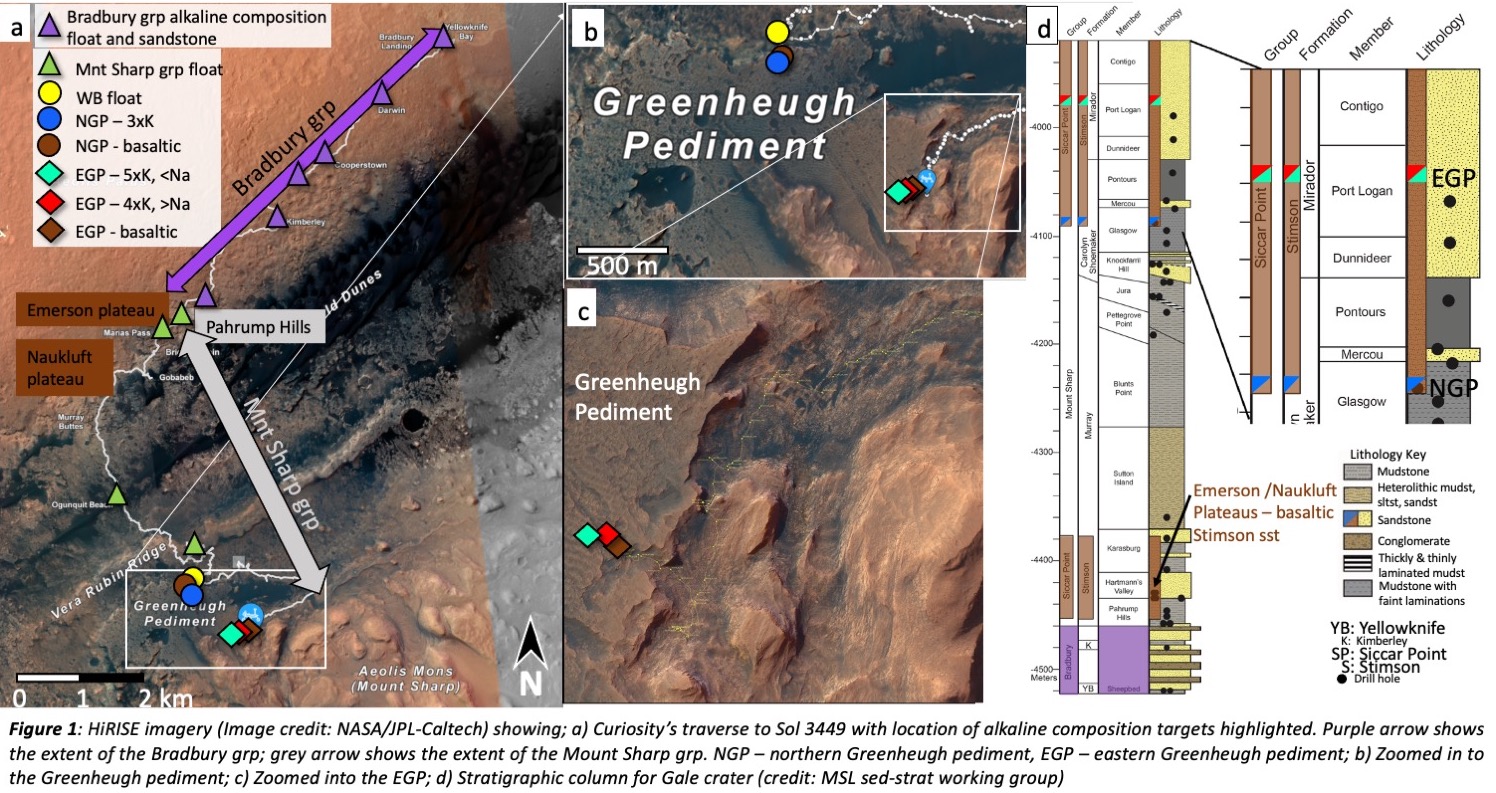
APXS results:
Basaltic composition sandstones, related to average Mars sand and soil, were identified at all three Stimson locations (Figures 1,2). All compositions are discussed here, relative to typical basaltic Stimson chemistry. Sandstones with 3xK2O and >MnO concentrations are identified on the northern GP overlying basaltic composition sandstones (Figures 1,2) [13-14]. Most recently, on the eastern GP, APXS analyses have revealed sandstones with even >K2O concentrations that fall into two groups (Figures 1,2): 1) with ~4xK2O, trending to >Na2O concentrations, and 2) with ~5xK2O, trending to <Na2O, Al2O3, and Ni, ≫Zn and Ge, and ≈MgO concentrations. The eastern GP, high-K sandstones also overlie more typical basaltic chemistry sandstones.
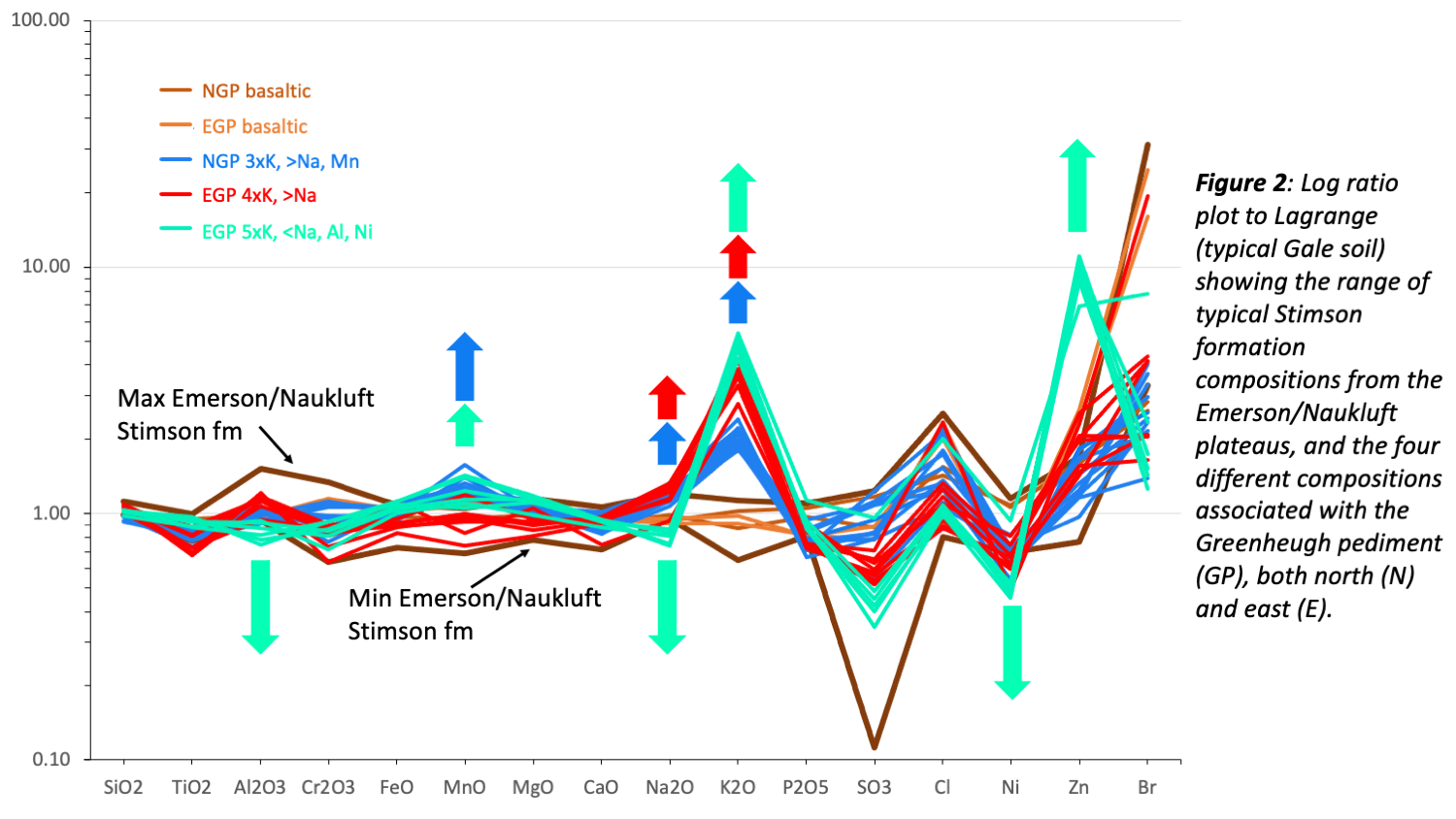
Compositional relationship to Bradbury group and other targets previously encountered on the mission:
The higher-K, Stimson sandstones share many compositional characteristics with Bradbury group rocks as well as several float rocks encountered along the Mount Sharp group traverse [13-14] (Figures 3,4). The CCAM instrument has also detected similar relationships [15]. The Bradbury group targets include sandstones near the landing site, high-K Bathurst and Kimberley formation sandstones, and capping sandstones situated just prior to driving on to the Mount Sharp group. Related composition float rocks analyzed along the Mount Sharp traverse are typically associated with Stimson outcrops.
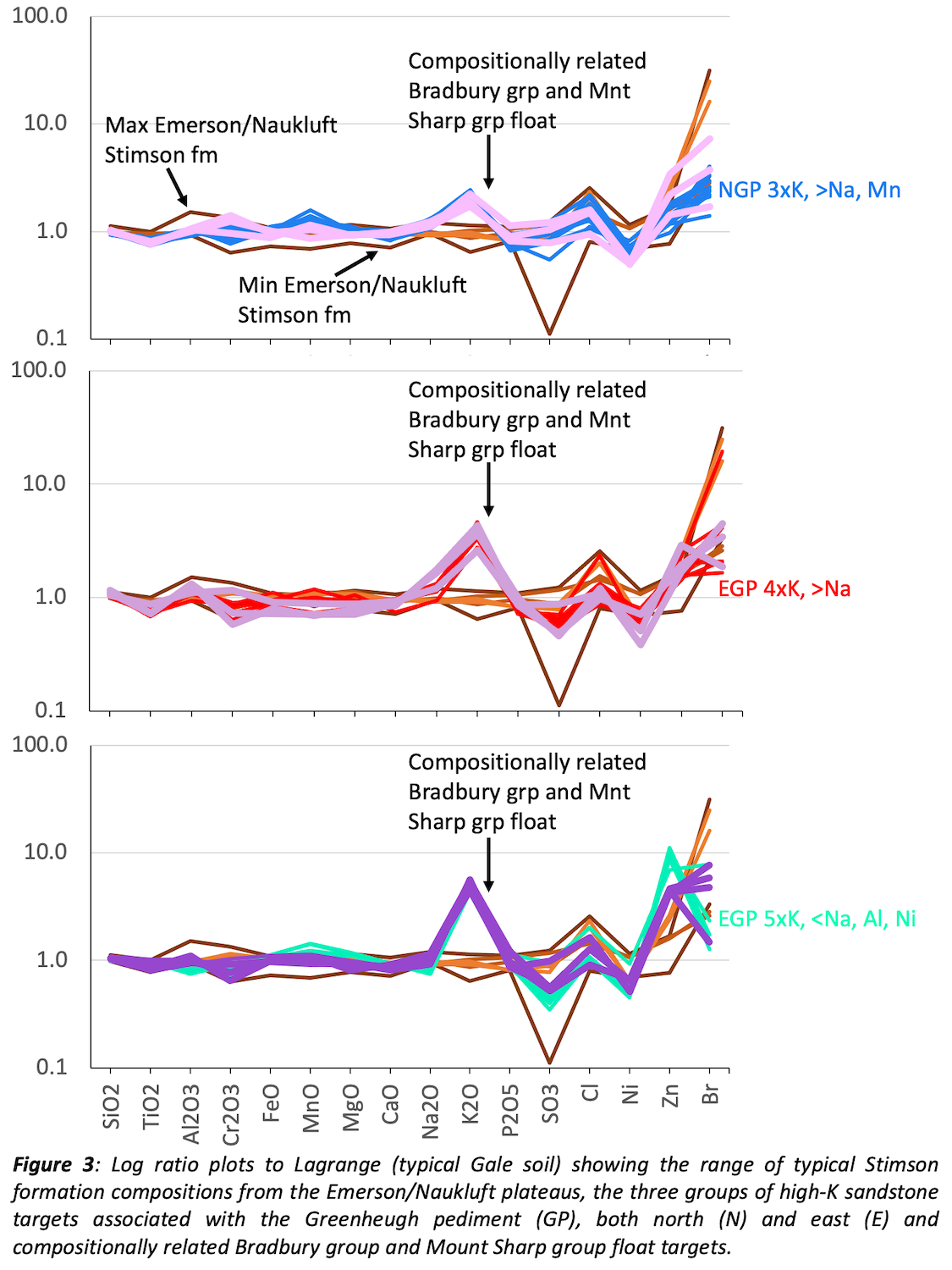
The higher-K Stimson sandstones do not plot on the sorting trend defined by the varying grainsize, modern Gale crater sands, and the basaltic Stimson sandstones on an A-CN-K diagram (Figure 4b). Instead, they are offset parallel to the plagioclase–potassium feldspar join. Thus, we do not attribute the compositional differences between the basaltic and high-K pediment Stimson to be the result of eolian sorting. Instead, based on sedimentology [3], mineralogy [16], and composition [13-14], we invoke a change in provenance, with input of a more potassium feldspar-rich source. Given the compositional relationship to Bradbury group sandstones, we suggest that the high-K Stimson sandstones are also derived from the mixing of multiple, igneous source rocks including basaltic and more alkaline compositions [13-14].
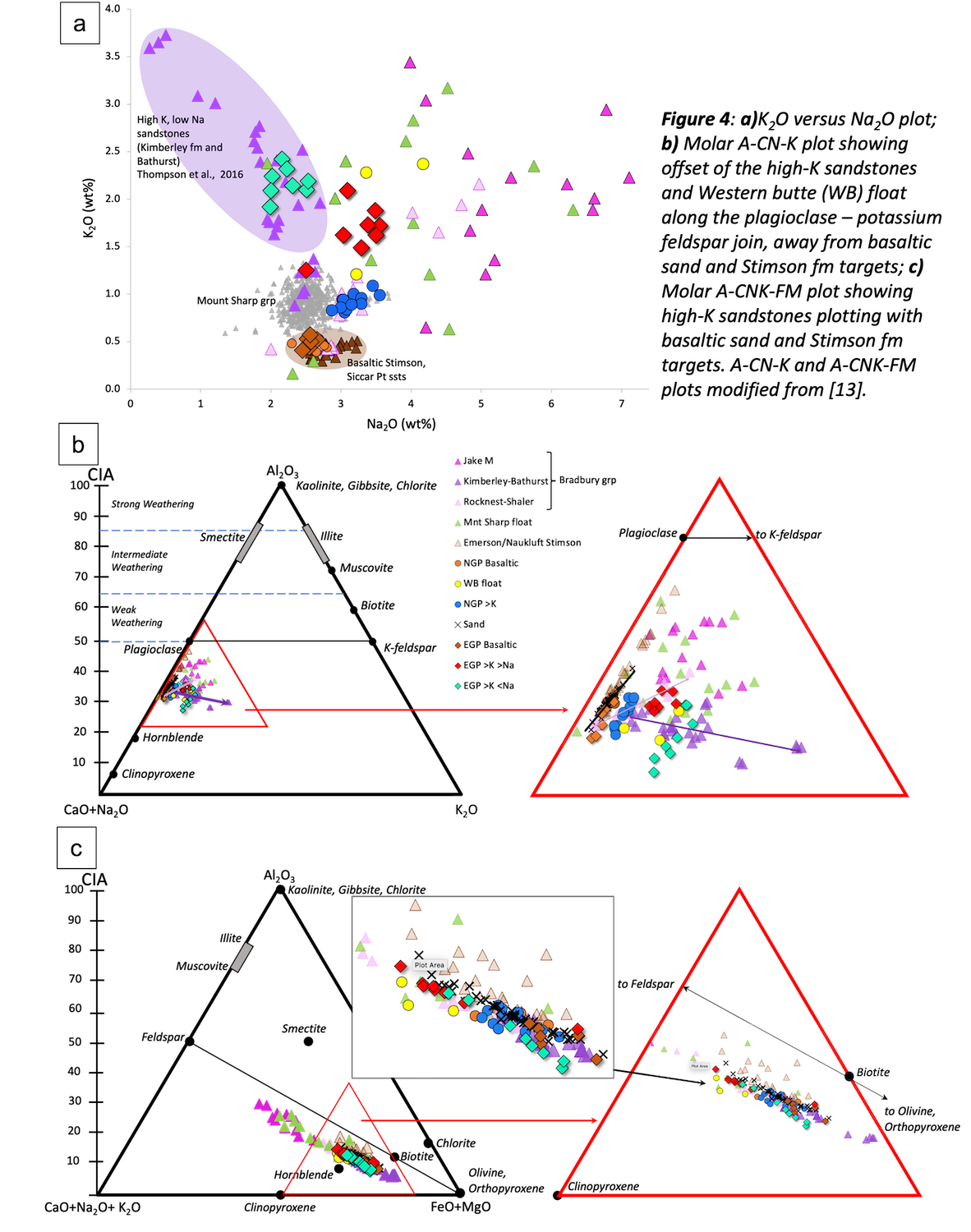
Many of the Bradbury group sandstones, Mount Sharp float and higher-K, pediment sandstones are also texturally alike. They are all relatively smooth, resistant, and blockier in appearance than typical basaltic Stimson sandstone (Figure 5). The high-K pediment and Bradbury sandstones also share similar orbital characteristics; both are manifest as crater-retaining units.
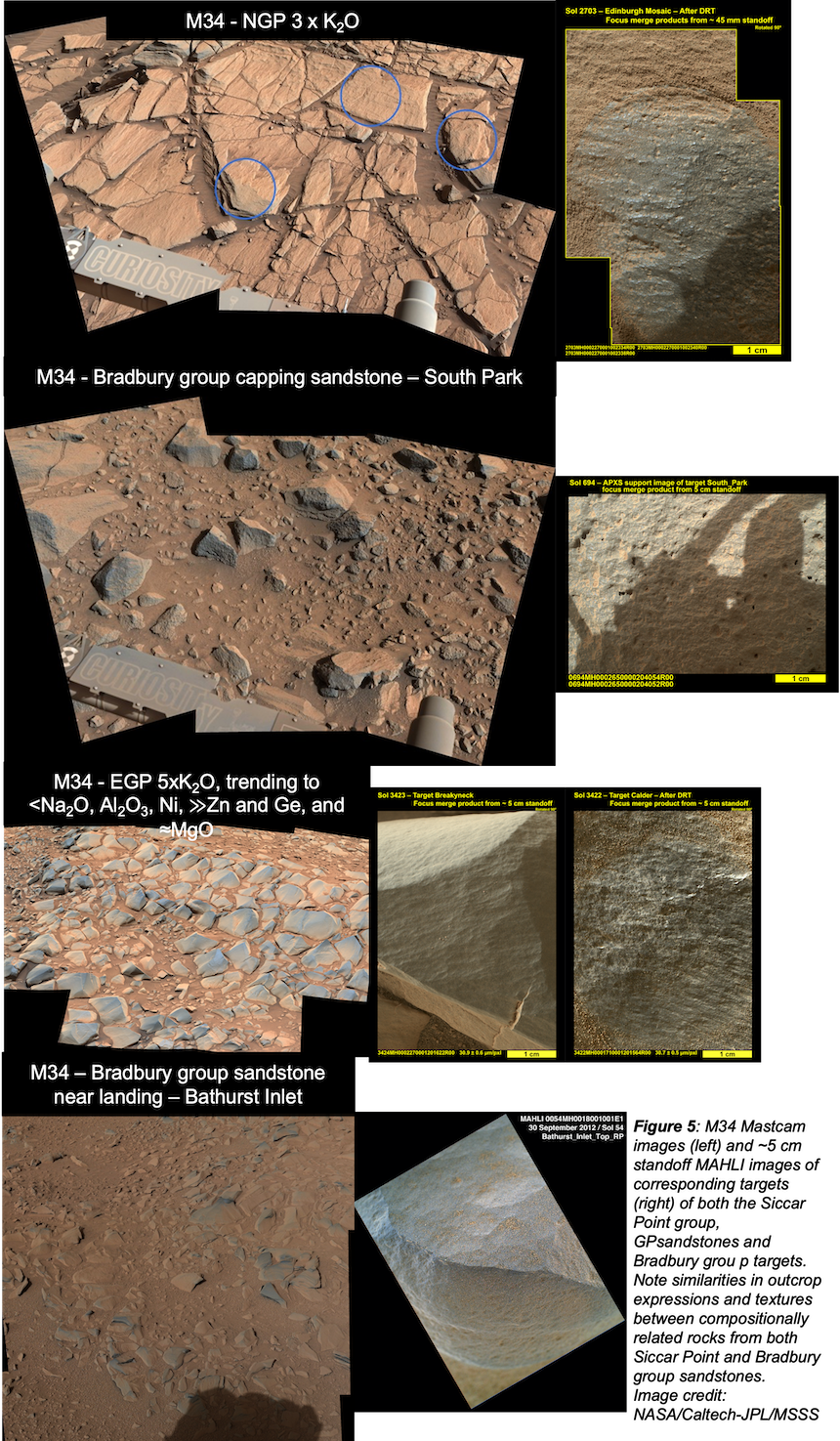
Timing Implications:
The more alkaline composition Bradbury group sandstones near the landing site are >9 km lateral distance and 400 m of elevation from the high-K pediment sandstones. Therefore, we have found evidence along the entire traverse for the presence of alkaline igneous source rocks. These source rocks have provided sediment input to both fluvial (Bradbury) and eolian (Siccar Point) sandstones [13-14]. Based on the compositional and textural relationships between the Bradbury and Siccar Point groups we revisit the timing of events at Gale.
The Bradbury group is generally considered to be older than both the Mount Sharp and Siccar Pt groups (Figure 1). This work raises the possibility that they could instead be contemporaneous, with both being younger than the Mount Sharp group. In this scenario, the Mount Sharp group represents relatively old lacustrine/fluvial deposits, which were buried, lithified, and eroded, before deposition of the Bradbury and Siccar Point groups onto that erosional surface, thus explaining differences in elevation between the two groups (Figure 6a). Alternatively, the Bradbury group alkaline sedimentary rocks are the oldest unit and would have been deposited prior to the Mount Sharp group. The Siccar Point group eolian sandstones (basaltic and alkaline) would then have been deposited on to the Mount Sharp group (Figure 6b). In this case, a more alkaline source area in the vicinity of, or within, Gale crater has been eroded by both water and wind at different times during the history of the evolution of the crater and its infill [13-14]. Both scenarios are consistent with widespread evidence at Gale crater for the presence of multiple igneous source rocks.
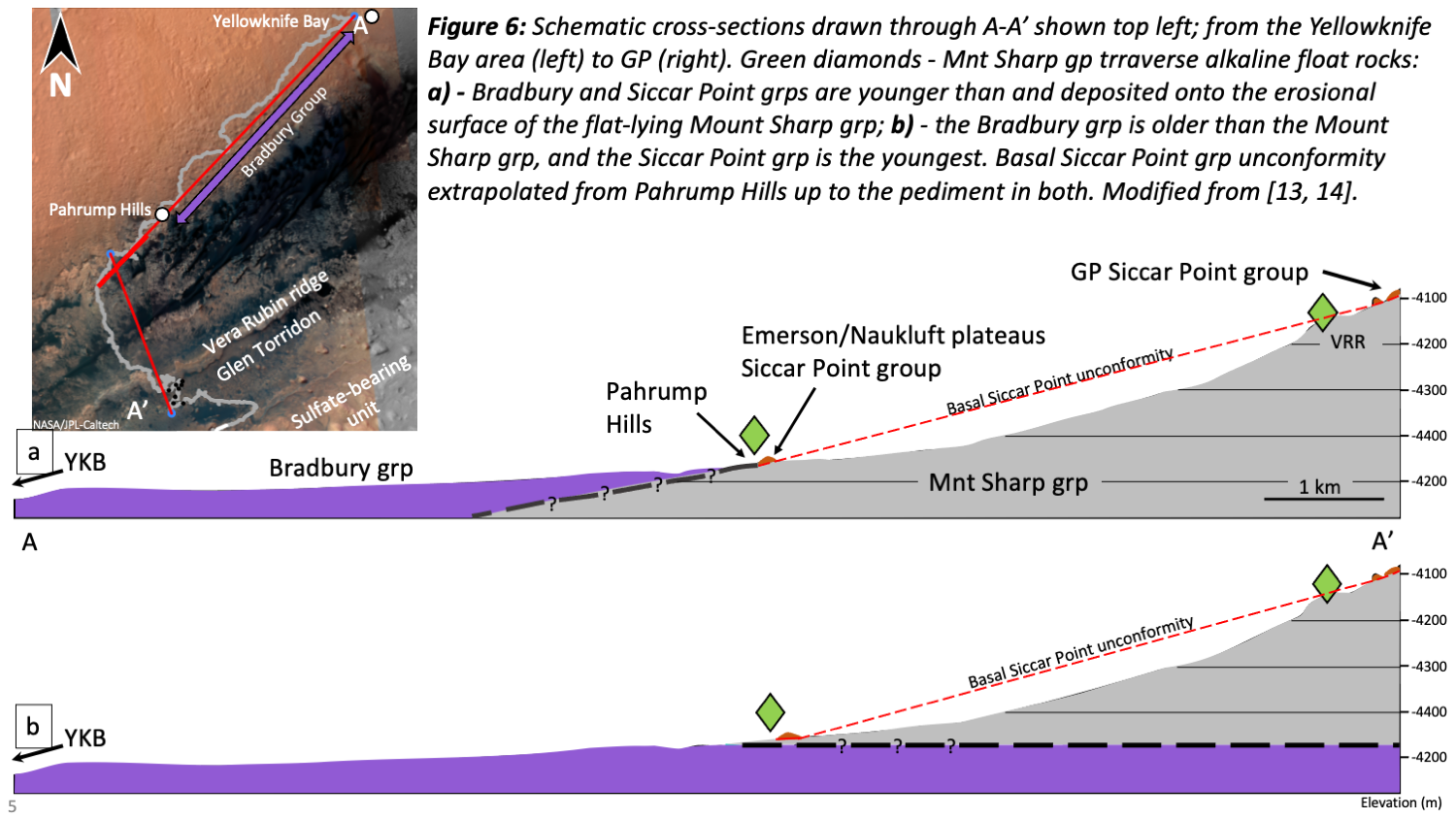
Acknowledgements:
MSL APXS is managed and financed by the Canadian Space Agency (CSA). Thanks to the JPL engineers and MSL science team.
References:
[1] Banham, S.G., et al. (2018) Sedimentology, 65, 993–1042. doi.org/10.1111/sed.12469
[2] Banham, S.G., et al. (2021) JGR: Planets, 126 (4): e2020JE006554
[3] Banham, S.G., et al. (submitted) JGR: Planets
[4] Watkins, J.A., et al. (2016) 47th LPSC, Abstract #2939
[5] Stolper, E.M., et al. (2013) Science 341 (6153), 1239463. doi:10.1126/science.1239463
[6] Schmidt, M.E., et al. (2014) JGR Planets, 119(1):64-81, doi:10.1002/2013JE004481
[7] Sautter, V., et al. (2015) Geoscience, 8(8), 605.
[8] Thompson, L.M., et al. (2016) JGR Planets, 121(10):1981-2003, doi:10.1002/2016JE005055
[9] Treiman, A.H., et al. (2016) JGR Planets, 121(1), p.75 – 106. doi:10.1002/2015JE004932
[10] Cousin, A., et al. (2017) Icarus 288, 265-283. doi:10.1016/j.icarus.2017.01.014
[11] Edwards, P.H., et al. (2017) MAPS, 52 2931-2410. doi.org/10.1111/maps.12953
[12] Bedford, C.C., et al., (2019) Geochimica et Cosmochimica Acta, 246, 234-266. doi.org/10.1016/j.gca.2018.11.031
[13] Thompson, L.M., et al., (submitted) JGR Planets 2021JE007178
[14] Thompson, L.M., et al., (2022) 53rd LPSC, 1475.pdf
[15] LeDeit, L., et al. (this conference)
[16] Thorpe, M.T., et al. (Submitted) JGR Planets 2021JE00709
How to cite: Thompson, L., Spray, J., Gellert, R., Williams, R., Berger, J., O'Connell-Cooper, C., Yen, A., McCraig, M., VanBommel, S., and Boyd, N.: APXS-determined compositional diversity of eolian Siccar Point group sandstones, Gale crater Mars: Implications for provenance and timing of events, Europlanet Science Congress 2022, Granada, Spain, 18–23 Sep 2022, EPSC2022-1184, https://doi.org/10.5194/epsc2022-1184, 2022.

